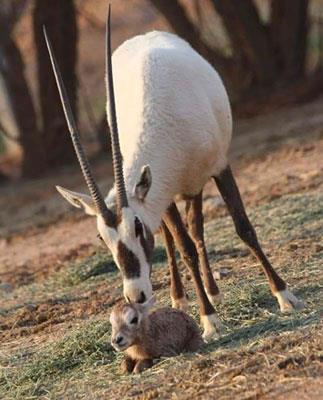
Facing Extinction Once, Iconic Arabian Oryx Is Now Breathing Life Into Jordanian Desert
The 22-square-kilometre reserve, established under the directives of the late King Hussein, became home to the first reintroduced Arabian Oryx in 1978 through the Royal Society for the Conservation of Nature (RSCN), Shaumari Wildlife Reserve Supervisor Obaidah Khraisheh recently said.
Khraisheh said that the reserve's mission is to manage environmental systems that maintain biodiversity and ensure the antelope's survival within its natural habitat.
"The goal is to eventually release individuals beyond the reserve's borders, confident in their ability to thrive without human intervention," Khraisheh explained.
The reserve also focuses on the re-settlement and protection of other threatened species, including wild Asian reds, Reem deer, and the blue-necked ostrich, boasting a catalogue of 193 plant species.
The disappearance of the Arabian Oryx from the Jordanian desert in the mid-20th century resulted from poaching and locust control campaigns. "Many Arabian Oryx were poisoned due to locust control campaigns in the 1950's," Khraisheh noted. "The last sighting of the Arabian Oryx in its natural environment was in 1965."
Khraisheh said that the reintroduction programme in Jordan began with 11 Arabian Oryx, eight of which were imported from the Santiago Animal Park in the United States and three donated by Qatar.
The small initial population led to genetic defects due to inbreeding. To address this, Khraisheh said that the RSCN collaborated with organisations in Saudi Arabia, obtaining 15 genetically diverse individuals and initiating a successful cross-breeding programme.
By the mid-90's, Khraisheh said that the population soared to 231, earning the reserve a spot in the Guinness Book of World Records as the largest Arabian Oryx population among the countries of Saudi Arabia, Oman, the UAE, and Qatar.
As a result of re-introduction programmes worldwide, the wild population of Arabian Oryx reached approximately 1,000 individuals in 2011, leading to the species being reclassified from Endangered to Vulnerable on the IUCN Red List.
He said that due to the reserve's limited area and resources, many Oryx were relocated to Qatar, the UAE, Saudi Arabia, Oman, and Iraq, leaving about 120 individuals in Shaumari.
“Approximately 25 per cent of these Oryx are in designated breeding areas, while the rest roam freely within the reserve's natural boundaries.”
The Arabian Oryx is of significant national symbolism in Jordan, known as the Jordanian desert icon and the national animal.
During the celebration of the Silver Jubilee of His Majesty King Abdullah, a statue of the Arabian Oryx was presented, representing the Azraq Governorate. Adapted to harsh desert conditions, the Oryx, much like the camel, is resilient in the arid landscape.
The medium-sized antelope, according to Khraisheh, rests during the heat of the day and can detect rainfall from 90 kilometres away, moving towards it instinctively.
He added that the Oryx's preferred habitat includes vast, simple lands, slightly varied in elevation, covered by stones, and surrounded by streams and valleys.
The remarkable comeback of the Arabian Oryx is a testament to Jordan and the Royal family's dedication to wildlife conservation and the enduring spirit of this iconic species.

Legal Disclaimer:
MENAFN provides the
information “as is” without warranty of any kind. We do not accept
any responsibility or liability for the accuracy, content, images,
videos, licenses, completeness, legality, or reliability of the information
contained in this article. If you have any complaints or copyright
issues related to this article, kindly contact the provider above.

















Comments
No comment